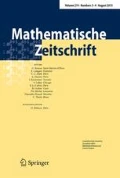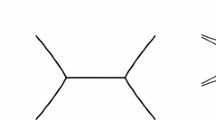Abstract
In this paper, we use geometry of numbers to relate two dual Diophantine problems. This allows us to focus on simultaneous approximations rather than small linear forms. As a consequence, we develop a new approach to the perturbation theory for quasi-periodic solutions dealing only with periodic approximations and avoiding classical small divisors estimates. We obtain two results of stability, in the spirit of the KAM and Nekhoroshev theorems, in the model case of a perturbation of a constant vector field on the \(n\)-dimensional torus. Our first result, which is a Nekhoroshev type theorem, is the construction of a “partial” normal form, that is a normal form with a small remainder whose size depends on the Diophantine properties of the vector. Then, assuming our vector satisfies the Bruno–Rüssmann condition, we construct an “inverted” normal form, recovering the classical KAM theorem of Kolmogorov, Arnold and Moser for constant vector fields on torus.
Similar content being viewed by others
References
Arnol’d, V.I.: Small denominators. I. Mapping the circle onto itself. Izv. Akad. Nauk SSSR Ser. Mat. 25, 21–86 (1961)
Banaszczyk, W.: Inequalities for convex bodies and polar reciprocal lattices in \({\bf R}^n\). II. Application of \(K\)-convexity. Discrete Comput. Geom. 16(3), 305–311 (1996)
Bugeaud, Y., Laurent, M.: On exponents of homogeneous and inhomogeneous Diophantine approximation. Mosc. Math. J. 5(4), 747–766 (2005)
Bounemoura, A., Niederman, L.: Generic Nekhoroshev theory without small divisors. Ann. Inst. Fourier 62(1), 277–324 (2012)
Bourbaki, N.: Algèbre, 3rd ed. ch. II, Hermann (1962)
Bounemoura, A.: Optimal stability and instability for near-linear hamiltonians. Ann. Henri Poincaré 13(4), 857–868 (2012)
Cassels, J.W.S.: An Introduction to Diophantine Approximation. Cambridge Tracts in Mathematics and Mathematical Physics No. 45, Cambridge University Press, Cambridge (1957)
Cassels, J.W.S.: An Introduction to the Geometry of Numbers. Grundlehren der Mathematischen Wissenschaften, No. 99. Springer, Berlin (1959)
Davenport, H., Schmidt, W.M.: Approximation to real numbers by quadratic irrationals. Acta Arith. 13, 169–176 (1967)
Davenport, H., Schmidt, W.M.: Approximation to real numbers by algebraic integers. Acta Arith. 15, 393–416 (1969)
Fassò, F.: Lie series method for vector fields and Hamiltonian perturbation theory. Z. Angew. Math. Phys. 41(6), 843–864 (1990)
Gruber, P.M., Lekkerkerker, C.G.: Geometry of Numbers, vol. 37, 2nd edn. Elsevier Science Publishers, Amsterdam (1987)
Hardy, G.H., Wright, E.M.: An introduction to the theory of numbers, 3rd edn. Oxford University Press, Oxford (1954)
Khanin, K., Lopes, D., Marklof, J.: Renormalization of multidimensional Hamiltonian flows. Nonlinearity 19(12), 2727–2753 (2006)
Khanin, K., Lopes, D.: Multidimensional continued fractions, dynamical renormalization and KAM theory. Commun. Math. Phys. 270(1), 197–231 (2007)
Kolmogorov, A.N.: On dynamical systems with an integral invariant on the torus. Doklady Akad. Nauk SSSR (N.S.) 93, 763–766 (1953)
Kolmogorov, A.N.: On the preservation of conditionally periodic motions for a small change in Hamilton’s function. Dokl. Akad. Nauk. SSSR 98, 527–530 (1954)
Lekkerkerker, C.G.: Geometry of Numbers, 1st edn. Bibliotheca Mathematica, No. VIII, North Holland (1969)
Lochak, P.: Canonical perturbation theory via simultaneous approximation Russ. Math. Surv. 47(6), 57–133 (1992)
Mahler, K.: Ein übertragungsprinzip für konvexe Körper. Časopis Mat. Fysik. 68, 93–102 (1939)
Mahler, K.: On compound convex bodies I. Proc. Lond. Math. Soc. 5, 358–379 (1955)
Moser, J.: A rapidly convergent iteration method and non-linear differential equations. II. Ann. Scuola Norm. Sup. Pisa (3) 20, 499–535 (1966)
Moser, J.: Convergent series expansions for quasi-periodic motions. Math. Ann. 169, 136–176 (1967)
Niederman, L.: Prevalence of exponential stability among nearly integrable Hamiltonian systems. Ergod. Theory Dyn. Syst. 27(3), 905–928 (2007)
Pöschel, J.: KAM à la R. Regul. Chaotic Dyn. 16(1–2), 17–23 (2011)
Riesz, M.: Modules Réciproques. C. R. Congr. Int. Math., Oslo 1936, vol. 2, pp. 36–37 (1937)
Rüssmann, H.: Invariant tori in non-degenerate nearly integrable Hamiltonian systems. Regul. Chaotic Dyn. 6(2), 119–204 (2001)
Rüssmann, H.: KAM-iteration with nearly infinitely small steps in dynamical systems of polynomial character. Discrete Contin. Dyn. Syst. Ser. S 3(4), 683–718 (2010)
Schmidt, W.: Diophantine Approximation. In: Lecture Notes in Mathemetics, No. 785. Springer, Berlin (1980)
Waldschmidt, M.: Topologie des points rationnels, Cours de Troisième Cycle 1994/95, Preprint Univ. P. et M. Curie, Paris, 175 p.; available at http://www.math.jussieu.fr/~miw/texts.html
Yoccoz, J.-C.: Analytic linearization of circle diffeomorphisms, Dynamical systems and small divisors (Cetraro, 1998), Lecture Notes in Math., vol. 1784, Springer, Berlin, pp. 125–173 (2002)
Acknowledgments
We would like to thank deeply L. Niederman for bringing us to work together. The first author thanks P. Lochak and H. Eliasson for useful discussions on KAM theory, and is supported by a NSF grant DMS-0635607. The second author thanks M. Laurent and D. Roy, and is supported by Agence Nationale de la Recherche (Project HAMOT, ref. ANR 2010 BLAN-0115-01).
Author information
Authors and Affiliations
Corresponding author
Appendices
Appendix A: Bruno–Rüssmann condition
Recall that the set of Bruno–Rüssmann vectors \(\mathcal B _d\) was defined in Sect. 2.2, and in Sect. 3 we introduced another condition (A). The aim of this short appendix is to prove the following proposition.
Lemma 4.1
A vector \(\alpha \) satisfies condition (A) if and only if it belongs to \(\mathcal B _d\).
In the proof, we shall make use of integration by parts and change of variables formulas for Stieltjes integral.
Proof
First let us prove that there exists a continuous, non-decreasing and unbounded function \(\Phi : [1,+\infty ) \rightarrow [1,+\infty )\) such that
Recall from Proposition 2.2 that \(\Psi _\alpha =\Psi _d\) is left-continuous and constant on each interval \((Q_l,Q_{l+1}]\), \(l\in \mathbb{N }^*\) and on \([1,Q_1]\) with \(Q_1 \ge 1\). For any \(l\in \mathbb{N }^*\), let us choose a point \(b_l\in (Q_l,Q_{l+1}) \cap [Q_{l+1}-1,Q_{l+1})\) and define
If \(Q_1>1\), we choose a point \(b_0\in [1,Q_{1}) \cap [Q_{1}-1,Q_{1})\) and define \(\Phi _0\) on \([1,Q_1]\) similarly, otherwise if \(Q_1=1\) we simply define \(\Phi _0(1)=\Psi _{\alpha }(1)\), so that finally the function \(\Phi \) defined by
has all the wanted properties. The existence of such a function \(\Phi \) shows that in Corollary 2.5, the integral condition may be written equivalently in terms of \(\Psi _{\alpha }\), or also in terms of this function \(\Phi \).
Now let \(\Delta _\Phi (Q)=Q\Phi (Q)\) and \(\Delta _\Phi ^{-1}\) denotes the functional inverse of \(\Delta _\Phi \). From (4.1), we deduce the following inequalities:
From (4.2) it follows that \(\alpha \) satisfies condition (A) if and only if
By a change of variables, letting \(Q=\Delta _{\Phi }^{-1}(x)\), (4.3) is equivalent to
Now for \(t=\Delta _{\Phi }^{-1}(1)\) and \(T>t\), an integration by parts gives
and as \(T^{-1}\ln \Delta _{\Phi }(T)>0\), letting \(T\) goes to infinity in (4.5), condition (4.4) implies
Now, using the fact that \(\Delta _{\Phi }\) is increasing and assuming that (4.6) holds true, we also have
and therefore letting \(T\) goes to infinity in (4.5), condition (4.6) implies condition (4.4). So (4.4) and (4.6) are in fact equivalent. Since \(\ln \Delta _{\Phi }(Q)=\ln Q+\ln \Phi (Q)\), (4.6) is clearly equivalent to
Hence conditions (A), (4.3), (4.4), (4.6), (4.7) and \(\alpha \in \mathcal B _d\) are all equivalent, and this ends the proof. \(\square \)
Appendix B: Technical estimates
In this second appendix, we derive technical estimates concerning the Lie series method for vector fields. These are well-known (see [11] for instance, where this formalism was first used as far as we aware of), but for completeness we prove the estimates adapted to our need.
Lemma 5.1
Let \(V\) be a bounded real-analytic vector field on \(\mathbb{T }^n_s\), \(0<\varsigma <s\) and \(\tau =\varsigma |V|_{s}^{-1}\). For \(t\in \mathbb{C }\) such that \(|t|< \tau \), the map \(V^t : \mathbb{T }^n_{s-\varsigma } \rightarrow \mathbb{T }^n_s\) is a well-defined real-analytic embedding, and we have
Moreover, \(V^t\) depends analytically on \(t\), for \(|t|<\tau \).
Proof
This is a direct consequence of the existence theorem for analytic differential equations and the analytic dependence on the initial condition: on the domain \(\mathbb{T }^n_{s-\varsigma }\), for \(|t|<\tau \), \(V^t\) is well-defined, depends analytically on \(t\) and satisfies the equality
The statement follows. \(\square \)
Lemma 5.2
Let \(X\) and \(V\) be two bounded real-analytic vector fields on \(\mathbb{T }^n_s\), and \(0<\varsigma <s\). Then
Proof
First consider a real-analytic function \(f\) defined on \(\mathbb{T }^n_s\), and let \(\mathcal L _V f\) the Lie derivative of \(f\) along \(V\), that is
Now for \(|t|<\tau =\varsigma |V|_{s}^{-1}\), by Lemma 5.1, \(F(t)\) is a well-defined real-analytic function on \(\mathbb{T }^n_{s-\varsigma }\) and moreover the map \(F\) is analytic in \(t\), hence by the classical Cauchy estimate
Similarly, we have
Now, for \(1\le i \le n\), if \(X^i\) and \(V^i\) are the components of \(X\) and \(V\), then \(\mathcal L _X V_i-\mathcal L _V X_i\) are the components of \([X,V]\), so each component of \([X,V]\) is bounded, on the domain \(\mathbb{T }^n_{s-\varsigma }\), by \(2\varsigma ^{-1}|X|_s|V|_s\) and therefore
which is the desired estimate. \(\square \)
Lemma 5.3
Let \(X\) and \(V\) be two bounded real-analytic vector fields on \(\mathbb{T }^n_s\), and \(0<\varsigma <s\). Assume that \(|V|_s \le (4e)^{-1}\varsigma \). Then for all \(|t|\le 1\),
Proof
From the general identity
we have the formal Lie series expansion
Let \(s_i=s-in^{-1}\varsigma \) for \(1\le i \le n\), so that \(s_0=s\) and \(s_n=s-\varsigma \). Using Lemma 5.2, we have
and by induction
By assumption, \(|V|_s \le (4e)^{-1}\varsigma \) so
and therefore
Now for any \(n\in \mathbb{N }^*\), \(n!\ge n^ne^{-n}\), hence \((n!)^{-1}(2e)^{-n}(n|t|)^n \le (2^{-1}|t|)^n\) and since \(|t|\le 1\), the above series is bounded by \(2\). This proves the lemma. \(\square \)
The above estimate can be easily improved, but for \(t\ne 0\), the constant \(2\) cannot be replaced by \(1\).
Rights and permissions
About this article
Cite this article
Bounemoura, A., Fischler, S. A Diophantine duality applied to the KAM and Nekhoroshev theorems. Math. Z. 275, 1135–1167 (2013). https://doi.org/10.1007/s00209-013-1174-5
Received:
Accepted:
Published:
Issue Date:
DOI: https://doi.org/10.1007/s00209-013-1174-5



